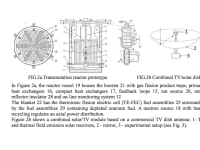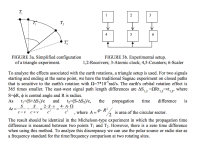The present photovoltaic (PV) cells use only about half of the light spectrum provided by the sun because the infrared part is not utilized to produce electricity. Without storage or backup generation, PV systems are not a continuous and reliable power source. As a result, they have high energy cost of manufacturing, installation and maintenance. In solar thermal systems, the entire incident spectrum is converted to heat. However, they are generally too complex for non-utility users.
The proposed design combines PV and energy storage-integrated thermal field emission (TFE) modules in the same dish engine or thermal micro-concentrator system. To thermally decouple these modules, a beam splitter is directing visible light into the PV and infrared radiation into the thermal or TFE modules. A photon-enhanced gate electrode creates an electrostatic field on the cathode surface that is large enough to compensate for the space charge field and initiate the TFE process. A graphite cavity-type solar receiver enclosed by a metal cup can act as a TFE cathode. In the cathodes with nano-structured surfaces, the current density can reach values close to the field emission limit but the direct current (DC) output voltage is low.
The solution is to convert DC into alternating current and/or join in a series of several modules to connect them directly to the grid or loads. An autonomous thermal and/or DC micro grid powered by portable TFE systems can be used for applications with remote deployment, because most domestic loads are DC. Present storage by batteries or fuel cell are also DC.
Schematics of two hybrid solar devices based on the existing concentrators are shown in Fig. 1. The cooling fluid is boiled when cooling the PV cells and TFE anode, and superheated vapor is generated at the thermal receiver/storage. To extent the design to the large concentration ratio, the high-performance heat pipes or evacuated-tube collectors can be used. To better meet specific customer demands, as well as to reduce the technical and financial risk for investors, the system is modularly configured for hybrid, thermal-only or electrical-only operations.
One dish that costs around 250,000 dollars has the average electricity price 11.33 cents per kWh. Once production rates rise it could cost less than 150,000 dollars. Since the dish is the most expensive part of the hybrid system, we could have a much lower cost and fastest energy payback time. The TFE devices with a high energy efficiency will also enable to harvest electricity from heat energy of the environment. A program can be beneficial in using existing buildings and infrastructure to construct TFE prototypes.
To analyze the systematic effects in the information or energy transfer between the power system and grid, a microwave or GPS antenna that simultaneously serves as a communication receiver and solar power production unit can be used. Particularly, the setup that utilizes time data from GPS satellites and counters controlled by scaler with trigger noise elimination can be used to estimate with high accuracy the frequency and power factors of the transmission system.
Like this entry?
-
About the Entrant
- Name:Anatoly Blanovsky
- Type of entry:individual
- Software used for this entry:AUTOCAD
- Patent status:pending








